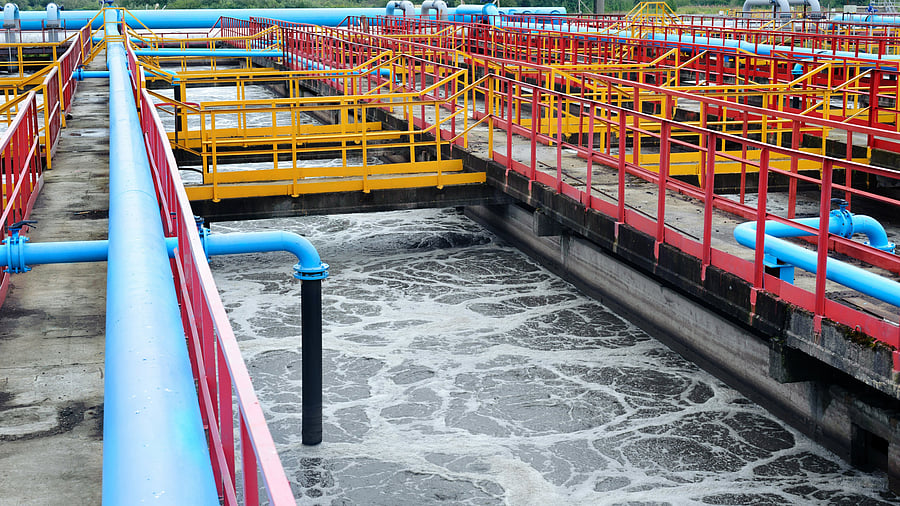
Water treatment facility with large pools of water Cleaning construction for a sewage treatment.
Credit: Special Arrangement
Wastewater from human settlements, mining activities, and industries is often contaminated with pharmaceuticals, pesticides, hydrocarbons, and personal care products. According to a 2017 United Nations report, nearly 80% of the world’s wastewater is discharged without treatment.
One of the UN’s Sustainable Development Goals states: “By 2030, improve water quality by reducing pollution, eliminating dumping, and minimising release of hazardous chemicals and materials, halving the proportion of untreated wastewater and substantially increasing recycling and safe reuse globally.”
Biological treatment is generally preferred due to economic considerations; however, it is often found to be inadequate in efficiently degrading non-biodegradable or recalcitrant pollutants. As a result, supplementary techniques are being adopted in wastewater treatment, including electrocoagulation, membrane filtration, adsorption, and advanced oxidation processes—namely, photocatalysis, ultraviolet/hydrogen peroxide, and ozone application.
Bioremediation, for instance, has been used for over two decades to improve the water quality of urban lakes. Beneficial bacteria or algae are introduced into the water body to help oxidise pollutants and suppress harmful bacteria. This can significantly improve the biological oxygen demand (BOD) and dissolved oxygen (DO) levels, effectively cleaning the water body.
If we take the example of Bengaluru, in 2004, the Lake Development Authority of Karnataka attempted bioremediation at Bellandur Lake, which spans over 936 acres. The agency engaged for the work was to be paid approximately ₹5 crores. The process involved the removal of water hyacinth weeds, continuous oxygen supply through power points around the lake, and the application of bioproducts, substrates, and enzymes once initial water quality improved. The treatment aimed to prevent untreated sewage from entering the lake.
At that time, Bangalore Water Supply and Sewerage Board (BWSSB) could not treat all the 1200 MLD of sewage generated within the corporation limits, and nearly 300 MLD continued to enter Bellandur Lake. Consequently, the lake’s water quality deteriorated further, and the remediation effort was abandoned. The materials and bioproducts brought by the agency were subsequently used in the smaller Madivala Lake, which had no sewage inflow, and there, the treatment yielded encouraging results.
However, bioremediation alone does not raise water quality to drinking standards. For that, secondary and tertiary treatment processes are essential. A 1994 research reported success in removing 300 mg/L of organic compounds from oil-reclaiming wastewater using oxidation methods, including ozone and hydrogen peroxide, as well as ultraviolet radiation with titanium dioxide.
The UV-TiO₂ treatment lasted five hours. It consumed 0.9 kWh per litre, removing 70% of the organic load while improving the biodegradability of the remaining material. In contrast, ozone and hydrogen peroxide alone removed only 17% of the organics, though they too enhanced biodegradability.
Newer treatment methods
Researchers at Nagaland University have developed bio-based soft technologies that operate through microbial action, plant uptake, and ecological interactions. These systems are energy-efficient and utilise plants, algae, and microbes working together in a self-sustaining environment.
Chinese researchers have made notable progress in various treatment strategies. Moloantoa et al. used metagenomic tools to develop a bioremediation approach for removing nitrate from mine wastewater. By supplementing with metal enzymes like iron and copper, they achieved complete denitrification at concentrations exceeding 500 mg/L.
In another study, Chinese researchers achieved 93% nitrogen removal from pharmaceutical wastewater using an anaerobic sequencing batch reactor (SBR) combined with a modified sequencing batch biofilm reactor (SBBR). Another set of researchers investigated the removal of organophosphorus pesticides using a copper-iron bimetallic system, achieving 99% phosphorus removal and a 65% reduction in organic carbon. Yet another research investigated the degradation of sulfamethoxazole in a membrane bioreactor, achieving 85% efficiency in waste removal.
These findings suggest that, in addition to biological methods, materials such as zeolites are highly effective adsorbents for organic compounds. Additionally, combining graphene oxide with nanoscale zero-valent iron has been found to enhance photoactivity under visible light, thereby improving charge carrier separation and treatment efficiency.
Advanced oxidation processes (AOPs) are also gaining prominence in tertiary water treatment. B.T. Ibigbami et al., in a paper published in the Journal of Applied Research and Technology, highlighted the effectiveness of hydroxyl radicals in achieving non-selective oxidation of contaminants, converting them into carbon dioxide and water. This process has shown promising results in treating abattoir wastewater and becomes more effective when combined with physical and biological treatments.
Effective and scalable solutions
Numerous studies have focused on removing recalcitrant organics from industrial wastewater. Often, hybrid solutions have proven more efficient. For example, scientists Madhumita Manna, Vijay Kanti Dutta, and Sujit Sen from the National Institute of Technology, Rourkela, developed a nanocomposite-based ceramic membrane incorporating microbubbles to treat wastewater from a dye factory. Their approach, which integrates photocatalysis, microbubbles, and membrane separation, resulted in 95.4% degradation of the Bismarck Brown R dye and a 94% reduction in Chemical Oxygen Demand (COD). Their research, published in the Journal of Environmental Chemical Engineering, showcases the potential of ceramic and polymeric membranes in industrial separation technologies.
While challenges remain, many of these technologies are cost-effective and scalable. Their deployment, particularly when matched to local conditions and combined with proper regulation and monitoring, can significantly advance efforts to meet the United Nations’ water quality targets by 2030.
(The author is a retired IFS official and an environmental communicator)